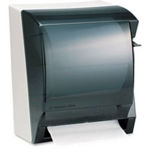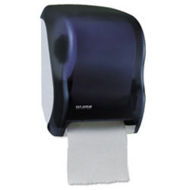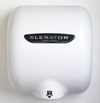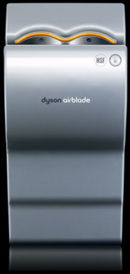Paper towel dispenser redesign
From DDL Wiki
Contents |
Executive Summary
Market Research and Observations
This is where usability study goes.
Top Stakeholders' Needs
Sketches and Descriptions of New Designs
Competitors and Pugh Chart
Competitors
Looking at other products, we found that the main competitors to the Kimberly-Clark In-Sight Sanitouch 09990 to be other designs of paper towel dispensers and air dryers. Below we listed the most significant models and also what we deemed the best competitors.
- Lever Arm Dispenser<ref name="Lever Arm Details">http://www.restockit.com/Dispenser-Insight-Roll-Towel-Smoke-Gray--(09736KIM)---TOP-SELLER!.html</ref>
Kimberly-Clark In-Sight Lev-R-Matic II 09736
This lever-operated paper towel dispenser requires the user to pull down on the lever to advance the paper. To increase the length of the paper, the user must use the lever more than once. There are some variations on this design, where some of the levers are along the bottom of the dispenser. This can allow the user to use their arm or elbow to advance the towel, instead of using their hands. Overall, these are dispensers are fairly reliable and do not jam.
Pros: Translucent, smoked plastic makes it easier to see when paper towel is almost empty. Works relatively well with no jams.
Cons: Must touch lever to advance paper (not hygienic). If you want a long sheet, you must pull down the lever several times.
Price: $53
Cost per use (2 sheets at 8" x 12" apiece): $0.01667 per use. Using $40 per carton of 12-8" x 400' rolls.<ref name=" Paper roll Details">http://www.restockit.com/Recycled-Nonperforated-Paper-Towel-Rolls-8-W-x-400-ft-White-12-RollsCarton--(KIM02068).html</ref>
- Touchless Electronic Dispenser<ref name=" Touchless Electronic Details">http://www.restockit.com/Smart-Roll-Towel-Electronic-Dispenser-(SANT1400TBK).html</ref>
San Jamar T1400TBK Black Smart System with iQ Electronic Sensor
This dispenser is an electric dispenser that releases paper from a sensor to detect hand motion. It is powered by four D-sized batteries. The advantage of using a sensor, is that the user does not need to touch anything on the machine to advance the paper, and only has to touch the towel that he/she is using. The dispenser also has a variety of advanced features.
Pros: Hand sensor (hygienic). Paper length and delay adjustment. Replaceable drive module. Downloadable data usage to PDA. Relatively few jams. Break-resistant plastic.
Cons: Electric sensor may not "see" hand at first. Battery life. May take long to get multiple sheets.
Price: $126
Cost per use (2 sheets at 8" x 12" apiece): $0.01667 per use.
- XLerator Hand Dryer<ref name="Xlerator Details">http://www.exceldryer.com/Products/xlerator.asp</ref>
Excel Dryer - XLerator
The XLerator hand dryer is a heated hand dryer that uses an infrared optical sensor to detect hand motion. When the user wants to use it, the user puts his/her hands under the dryer and the XLerator blows air at a speed of 14,000 LFM (linear feet per minute) at the hands. The dryer uses a 900W heating element to produce a temperature up to 135°F at the hands. Excel Dryer claims you can dry hands completely in 10-15 seconds.
Pros: Cleans hands without touching machine (hygienic). Relatively quick. Warm air helps drying. No paper towel costs. No "empty" paper roll or maintenance needed.
Cons: Loud when operating. Electricity costs.
Price: $440
Cost per dry: Using average electricity cost per kWh in United States, $0.115/kwH <ref name="Electricity Cost">http://www.eia.doe.gov/cneaf/electricity/epm/table5_6_b.html</ref>
Using a drying time of 15 seconds and 0.9kW for the dryer, we have an average of 0.00375 kWh per use. This results in $4.3125e-4 per use.
- Dyson Airblade<ref name="Dyson Details">http://www.dysonairblade.com/homepage.asp</ref>
The Dyson Airblade uses a unique design that is similar to a windshield scraping water off glass. The Airblade uses ambient room temperature air that it cleans through a HEPA filter. It uses less energy since it is not heating up the air and is hygienic since it filters the air. To use it, the user places his/her hands into the device where an infrared sensor activates the device. Air blows on the hands and the user pulls them out, allowing the water to be scraped down into the dryer. Dyson claims that the airspeed at the nozzle is 400mph and you can dry your hands in 12 seconds.
Pros: Quick drying. No heat use. No paper towel use. Hygienic due to infrared sensor.
Cons: Costly. Slightly noisy. Uses electricity. Mounting height may be more difficult. Can only dry hands (not face).
Price: $1,300
Cost per dry: Electricity cost per kWh in United States, $0.0115/kwH. And 0.00468 kWh used per dry at 1.4kW and a 12 second drying time. This results in $5.382e-4 per use.
PUGH CHART
Existing Patents
Gantt Chart
Summary and Recommendations
Team Member Roles
References
<references/>
Appendix
(100 ideas)




